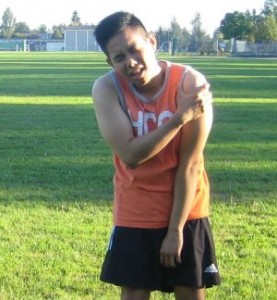The rotator cuff is composed of 4 muscles that function in moving and stabilizing the shoulder joint. Damage to any of these muscles and ligaments can occur due to an acute injury, gradual aging and chronic overuse that can result to severe pain, disability and reduced range of motion of the shoulder.
Causes of rotator cuff injuries
- Muscles and tendons in the rotator cuff group can be injured in many ways such as fall, chronic overuse such as throwing a ball or lifting and gradual degeneration of the muscles and tendons due to aging.
- Acute rotator cuff tears which develops from sudden raising of the arm against resistance such as cushioning a fall, lifting heavy objects and a fall on the shoulder.
- Occupations or sports that require overhead activities such as painters, baseball pitchers and tennis players.
- Repetitive trauma to the muscles due to daily movement of the shoulders
- Wearing out of muscles due to aging

Severe shooting pain on the upper shoulder area and spreads down the arm and elbow.
Symptoms
- Swelling and reduced range of motion
- Severe shooting pain on the upper shoulder area and spreads down the arm and elbow.
- Severe pain from bleeding and muscle spasms
- Pain becomes worse at night
- Decreased movement of the shoulder when pain becomes severe
- Incapable of abducting the arm such as moving out to the side, lifting the arm higher than the shoulder and to the front and side.
Treatment
- Get enough rest especially the affected shoulder to promote faster healing of the condition.
- Apply an ice pack on the area for at least 15-20 minutes for 3 times every day. Avoid applying the pack directly on the skin to prevent frostbite. Wrap the pack in a towel before applying on the affected area.
- Wear a sling to rest the shoulder but avoid wearing it for extended periods of time to prevent stiffness and diminished range of motion.
- Take the prescribed over-the-counter pain medications such as ibuprofen or naproxen to lessen the pain and swelling.
Tips
- To prevent reaching overhead repeatedly, use a step stool or ladder.
- Proper warm up and stretching exercises must be done before performing activities to prevent straining on the shoulder joint.
- People with arthritis of the knees should perform exercises to strengthen the quadriceps muscles in the thighs.
Disclaimer / More Information
The material posted on this page on rotator cuff injury is for learning purposes only. Learn to recognize and manage muscle and joint injuries including a rotator cuff injury by taking a first aid and CPR class with one of our training providers.
